|
|
|
|
Products mentioned in this Article
--None--
|
|
|
|
|
|
|
|
|
 |
|
|
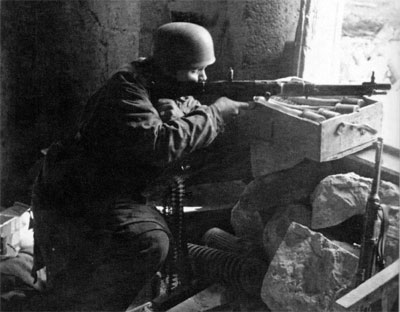 |
FG-42
Fallschirmjägergewehr 42 (Paratrooper rifle, model 1942)
The FG-42 is a rather interesting, yet ultimately unsuccessful, automatic rifle developed especially for the Fallschirmjäger. The Fallschirmjäger wanted a lighter automatic weapon after their experiences during the invasion of Crete. They had encountered weapons such as the British Bren, which was lighter than the standard MG-34, and they wanted a light support weapon of their own. The initial idea was further developed into a concept weapon that could handle all the roles required by the Fallschirmjager in the field, this new weapon would effectively replace the bolt-action rifles, submachine guns and machine guns already in service.
|
As a result, the FG-42 was developed. It could fire single shots semi-automatically, or serve as a light support weapon able to fire fully automatic. Its development was authorized by Hermann Göring.
Early in 1942 two companies, Rheinmetall-Borsig and Krieghoff, began development of the requested weapon. It was required, in the design brief, to be a selective fire (semi-automatic or full-automatic), lightweight, and fire the standard issue 7.92 x 57mm ammunition.
|
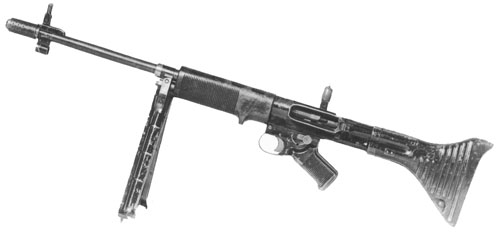 |
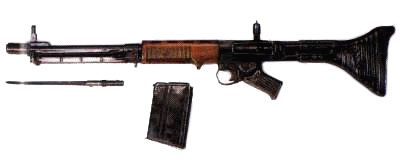 |
The prototypes from both companies were
submitted for tests in mid 1942. Initial tests proved the Rheinmetall
design the most suitable. As Rheinmetall’s production facilities were
already fully utilised manufacturing other weapons, the production
contract was given to Krieghoff.
The first model, known as FG-42-1, was made in
limited numbers, but a shortage of magnesium steel halted the
production at about 2000 rifles.
|
|
Krieghoff noted that the Rheinmetall design required much machining that slowed production and went about redesigning many parts to be made from simple steel stampings. By early 1944 the Krieghoff engineers had redesigned the FG-42 into 2nd model (FG-42-2). The use of more stamped parts meant that some machined parts had to be made heavier to retain the weapon’s strength and the new version was heavier and slightly longer.
In the field the FG-42 proved only partially effective in its assigned rolls, as a personal rifle it functioned well, but as a automatic support weapon it proved hard to control. It was too light to be effectively fired in full auto, even from its bipod.
Despite Kreighoff modifications it was still too expensive when compared to the Stg.44 assault rifle. Before the end of war about 5000 FG-42-2 rifles were produced by Krieghoff and several minor manufacturers.
Weapon Features
FG-42 is a gas operated, air-cooled, selective fire weapon. The long stroke gas piston located under the barrel operates a two lug rotating bolt. The action was designed so the rifle fired closed bolt for single shots (for maximum accuracy), and open bolt on full automatic (for better barrel cooling).
The magazine was inserted horizontally from the left, and contained either 10 or 20 rounds. The spent cases were ejected to the right.
|
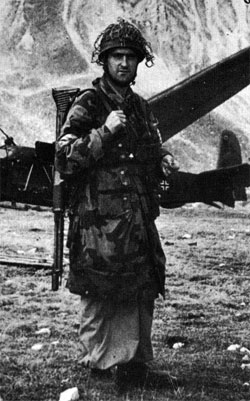 |
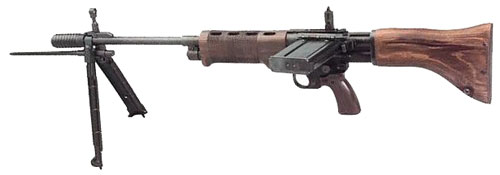 |
The FG-42-1 had the pistol grip inclined to the rear, to allow shooting downward from descending parachute, but this proved unnecessary, and FG-42-2 featured a more straightened pistol grip. Early FG-42-1 rifles had the butts made from stamped steel, while FG-42-2 had wooden butts.
|
|
Both models were fitted with bipods, the FG-42-1 hinged to the front of the receiver, and folded forward, the FG-42-2 one was mounted near to the muzzle, and hinged rearwards. All FG-42 rifles accepted mounts for the ZF-41 optical scope.
|
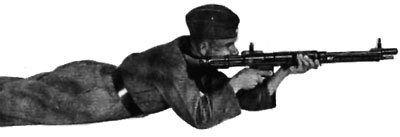 |
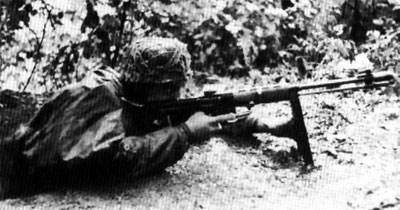 |
Fallschirmjägergewehr 42
Calibre: 7.92mm
Length overall: 940mm
Length of barrel: 502mm
Weight: 4.53kg (9.99lb)
Muzzle velocity: 761m per second
Magazine capacity: 20 rounds
Maximum combat range: 800m
Rate of fire: 750-800 rpm cyclic |
|
In Service 1943
The first production run of 2000 was issued to some of the Fallschirmjäger regiments starting in early 1943. There is limited information available about which units were issued them, though Fallschirmjäger Regiment 3 got some just before they went to Sicily. Small numbers were seen with Fallschirmjäger around Rome (when they disarmed the Italians), which predates the currently accepted wisdom of the first operational use in the raid to free Mussolini (which was heavily documented in photographs). Whether elements of Fallschirmjäger Regiment 5 received any before deployment in Tunisia is uncertain.
What is clear is they weren’t issued to whole units, so those that did have them had them mixed with other weapons.
|
Last Updated On Thursday, December 18, 2008 by Wayne at Battlefront
|
|
|